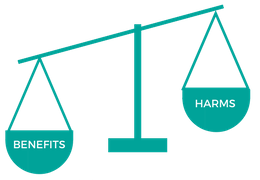Screening for Other Cancers
The goal of cancer screening is to reduce the number of people who die from cancer.
Cancer screening tests are able to detect cancer or pre-cancer before symptoms appear.

Every medical test has potential harms (bad things) and potential benefits (good things) that can occur. Potential benefits and potential harms are events that happened to enough people to make them important to know for informed decision-making.
Let's break it down...
Harm = a physical hurt or injury
Benefit = a gain or advantage
Potential = something that may or may not occur
Risk factor = anything that increases your chance of getting cancer
The potential benefits of cancer screening can include:
- cancer prevention (finding pre-cancer before it causes harm)
- early diagnosis (find cancer earlier when it is easier to treat)
- more treatment options
- better outcomes (less illness and death due to the disease)
The potential harms of cancer screening include:
- false positive test result (a normal test result that is comes back as abnormal)
- false negative test result (an abnormal test result that comes back as normal)
- overdiagnosis (finding and treating cancer that would not have caused death)
Evidence clearly demonstrates that the benefits of screening for breast, cervix, and colon cancer outweigh the potential harms for the eligible population.
BreastCheck
Most women age 50-74 should have a screening mammogram every 2 years.
Call 1-855-95-CHECK to make an appointment.
CervixCheck
Most women age 21-69 who have ever been sexually active should have a Pap test every 3 years.
Call your healthcare provider for an appointment or click here to find a Pap test clinic near you.
ColonCheck
Most men and women age 50-74 should do a home screening test (FOBT kit) every 2 years.
Click here to request a kit.
Should you Get Checked?
If you would like help to make an informed decision about having a cancer screening test:
- contact your healthcare provider,
- review our booklets for:
- BreastCheck (English | French) (PDF)
- CervixCheck (English | French) (PDF)
- ColonCheck (English | French) (PDF), or
- contact a CancerCare Manitoba Screening Program Health Educator at Screening@cancercare.mb.ca or 1-855-95-CHECK
Criteria for the Start of a Screening Program
For a screening program to be initiated, there are several criteria that must be satisfied. To read more, click here.
Screening for Other Cancers
If you have concerns about your cancer risk, speak to your healthcare provider. There is not enough evidence that screening people at average risk for other cancers is effective. There is, however, there is enough evidence to support the recommendation to screen high risk individuals for lung cancer.
Lung cancer risk factors include:
- smoking tobacco
- second-hand tobacco smoke
- radon exposure
- asbestos exposure
- history of certain lung conditions (e.g. chronic obstructive pulmonary disease, tuberculosis)
To reduce your risk of lung cancer:
- be a non-smoker
- avoid being around people who are smoking (second-hand smoke)
- limit exposure to known cancer-causing chemicals like asbestos
- test your home for radon (external link)
Taken from Canadian Cancer Society, March 2018.
Screening Recommendation
An annual low dose computed tomography (LDCT) for three years is recommended for males and females age 55-74 who:
- have at least a 30 pack-year* smoking history, and
- currently smoke or quit less than 15 years ago,or
- are at high risk according to personal history and lifestyle factors,
Talk to your healthcare provider about your level of risk for lung cancer.
*To calculate a person's pack year history (number of packs smoked daily) x (number of years smoked).
Ovarian cancer risk factors include:
- being caucasian
- being perimenopausal or postmenopausal
- having a BRCA1, BRCA2 or HNPCC gene mutation
- having never been pregnant
- a family history of ovarian or breast cancer
- a personal history of breast, endometrial or colorectal cancer
Things that reduce your risk of ovarian cancer:
- birth control pill use
- history of pregnancy
- history of breastfeeding
Screening Recommendation
There is currently not enough evidence for a reliable screening test that reduces the number of cancers and/or deaths from ovarian cancer. To learn more about ovarian cancer screening visit:
- Ovarian Cancer Canada
- The Canadian Task Force on Preventive Health Care has no current published guidelines for ovarian cancer.
Prostate cancer risk factors include:
- being male
- being over age 50
- of African-American or Caribbean ancestry
- having a brother or father with prostate cancer
- being BRCA1 or BRCA2 gene positive
- being diagnosed with Lynch syndrome (or hereditary non-polyposis colorectal cancer)
Taken from the American Cancer Society website on April 2, 2018.
To reduce your risk of prostate cancer:
- eat at least 2 1/2 cups of vegetables and fruits each day
- be physically active
- maintain a healthy weight
Taken from the American Cancer Society website on April 3, 2018.
Recommendation
The Canadian Task Force on Preventive Health Care does not recommend screening for prostate cancer with the PSA, as the harms of screening outweigh the benefits for men at average risk. The decision to screen for prostate cancer in males should involve a conversation between the client and their primary care provider.

